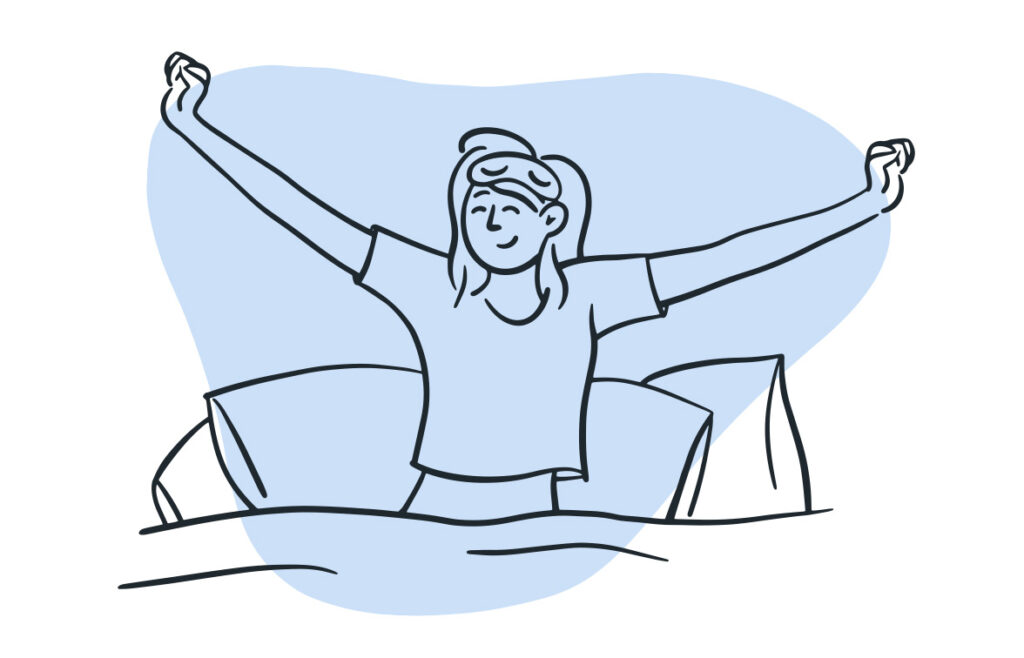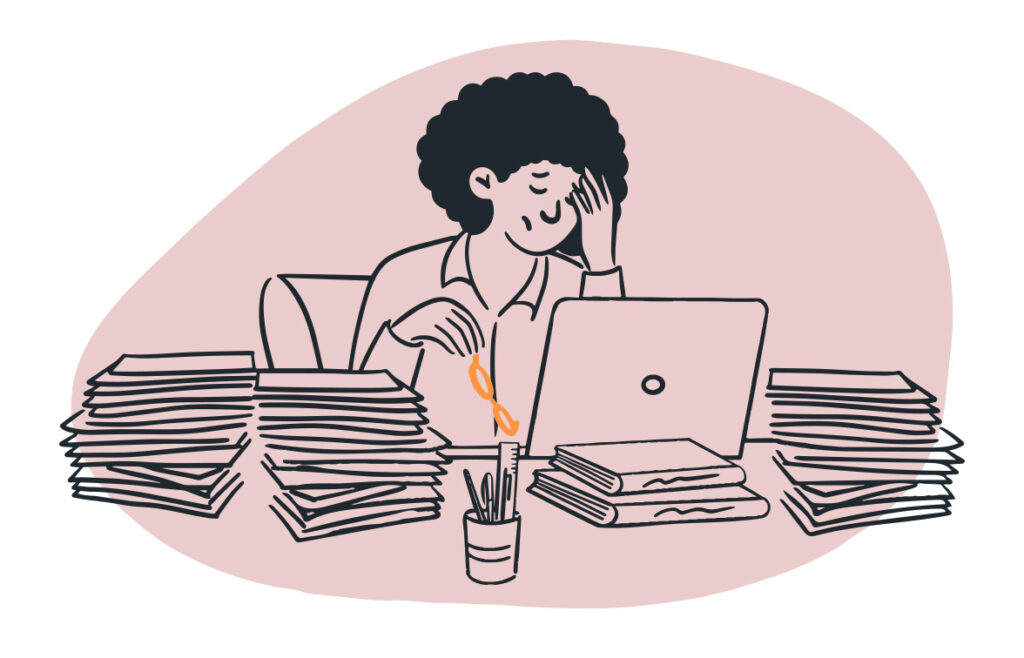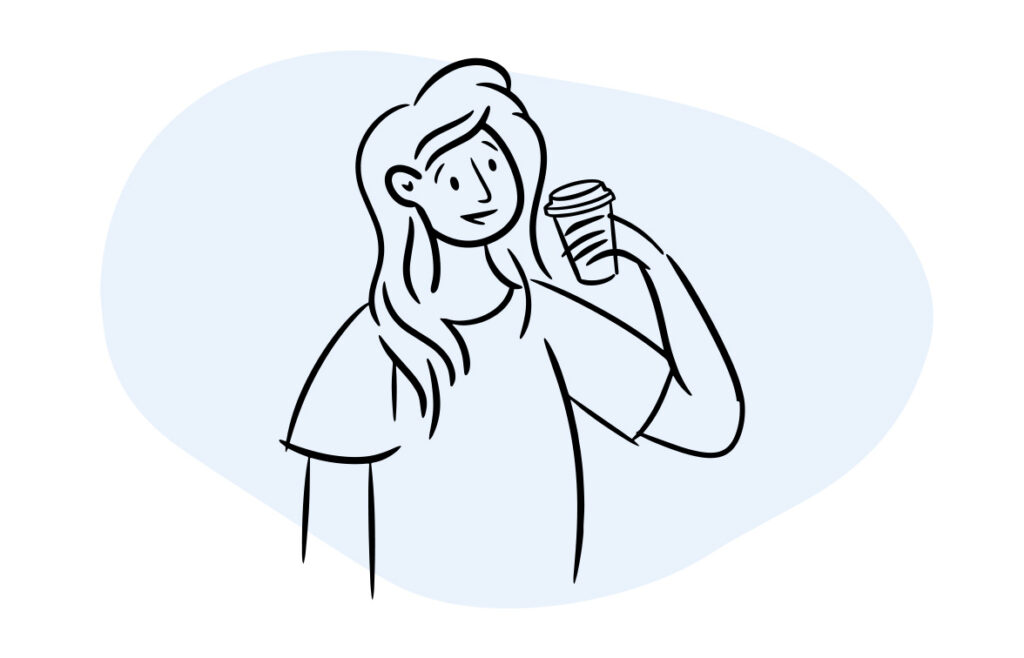Sleep Inertia: Tips To Get Over Morning Grogginess
Disclosure: By clicking on the product links in this article, Mattress Nerd may receive a commission fee at no cost to you, the reader. Read full disclosure statement.
If you ever get out of bed, but you’re not really awake yet, you might be experiencing sleep inertia (aka sleep drunkenness). This phenomenon can have a negative impact on cognition, making it difficult to make decisions or do basic tasks.
Sleep inertia is more common in folks with alternative sleep patterns. This includes shift workers, overnight workers, or those with rotating work schedules.
Read on for everything you need to know about sleep inertia, plus the best tips to make waking up easier.

What Is Sleep Inertia?
Sleep inertia is that groggy feeling you have immediately after you wake up. It can cause impaired cognition, drowsiness, and disorientation. It usually lasts about 30 to 60 minutes but can persist for up to a few hours.
While it would be great to spring awake with ease, there’s a reason why you experience sleep inertia. Researchers believe it’s a protective mechanism that helps you maintain sleep through unwanted wakings. (Think barking dogs, annoying neighbors, or passing traffic.)
Sleep inertia can lead to decreased alertness and slowed reaction times, increasing the risk of work-related injuries. It can also make it harder to focus while driving or operating other machines, which can be very dangerous.
Sleep drunkenness can be an issue for anyone. But it might have a more significant effect on shift workers, overnight workers, polyphasic sleepers, or those with rotating work schedules.
How Long Can It Last?
Generally, sleep inertia lasts about 30 to 60 minutes, according to the Centers for Disease Control and Prevention (CDC). But those who are chronically sleep-deprived might experience symptoms for up to a few hours.
Longer periods of sleep inertia are more common in shift workers who take naps during early morning hours.

What Causes Sleep Inertia?
Some researchers think that sleep inertia helps us maintain sleep through disruptions. Studies also show sleep inertia may stem from incomplete awakening or disconnecting from sleep.
Here are three other reasons why you might be experiencing sleep inertia.
Reduced Blood Flow
Blood flow to the brain follows a pattern that corresponds with sleep cycles. It either increases or decreases depending on which stage you’re in. Sometimes, there’s a delay in the time it takes for blood flow to speed up when you wake up. This can lead to grogginess, lack of coordination, or confusion.
Chronic fatigue syndrome (CFS) is associated with reduced cerebral blood flow. So, CFS can cause similar symptoms to sleep inertia. Talk with your doctor if you think you could have this syndrome.
High Adenosine Levels
Adenosine is a nucleic acid compound that’s found in the brain. It plays a significant role in sleep and wakefulness.
Your adenosine levels should be on the lower side when you wake up. But if the levels are still high, it can increase the likelihood of sleep inertia symptoms. This might be more common in those who experience chronic sleep deprivation.
Increase in Delta Waves
Some research suggests that sleep inertia is triggered by an uptick in delta waves in the posterior part of the brain. These slow waves occur during the non-rapid eye movement phase of sleep.
When the brain hasn’t reduced delta waves in preparation for waking up – or if you’re forced awake during a non-rapid eye movement sleep stage – you might feel extra groggy. Moreover, delta waves can increase after stretches of sleep loss or deprivation.
Sleep Inertia Symptoms
Sleep inertia symptoms are most present when you first wake up and slowly decrease. The effects can occur after a long stretch of sleep or naps over 30 minutes. The most common sleep inertia symptoms are:
- Grogginess
- Impaired visual attention
- Lowered spatial memory
- Impaired cognitive function
- Wanting to go back to sleep
Studies show that some people may also experience confusion, lack of coordination, and slowness.
Note that symptoms can vary a lot from person to person. But those who are sleep-deprived may have more severe symptoms than those who are well-rested.
Is Sleep Inertia Dangerous?
In most cases, sleep inertia is nothing to worry about. It can cause minor inconveniences, but generally doesn’t lead to long-lasting consequences. Sleep inertia can become more of a problem, however, if you do certain things while groggy.
For example, drowsy driving is hazardous. In 2017, drowsy driving was responsible for at least 91,000 car accidents. This included 50,000 injuries and 795 deaths, according to reports from the National Highway Traffic Safety Administration (NHTSA).
Additionally, shift workers that require strong cognition and decision-making skills – like pilots, nurses, military members, doctors, or truck drivers – might be at an increased risk of more severe consequences.

How To Stop Sleep Inertia
Ready to take charge of your groggy mornings? Here are eight tips to stop sleep inertia and feel less sluggish when you wake up.
- Take a quick nap. A quick cat nap may help reduce sleep inertia symptoms. Just remember to keep your naps under 30 minutes, or they can have the opposite effect.
- Try caffeine. Your morning cup of coffee – or any caffeinated beverage – can help you feel more alert when you wake up. Caffeine works by blocking adenosine receptors which can increase wakefulness. Just keep in mind that too much caffeine or taking it close to bedtime can negatively impact your sleep.
- Get a better bed. Sleeping on an uncomfortable bed can lead to poor sleep quality, which can lead to sluggish mornings. Upgrading your mattress may help.
- Take a cold shower. Right after you wake up, hop into a cold shower. The water will help jolt you awake and make you a lot more alert.
- Change your thermostat. Sleeping in a warm or hot room keeps your body from cooling, making it harder to fall asleep. This can lower sleep quality and make it harder to wake up in the morning. To prevent this, lower the thermostat, sleep with a fan on, use an air conditioner, and sleep in lightweight pajamas.
- Buy the right bedding. Get breathable and comfortable sheets and bedding for a better night’s sleep.
- Have a gentle wake-up. Lots of alarms are very loud and jarring, which can lead to feelings of anxiety, confusion, or grogginess. You might prefer a smart alarm clock or sunrise alarm clock that wakes you up little by little with gentle sounds.
- Go to sleep earlier. Plan an extra 30 to 60 minutes in your bedtime routine for extra rest. This might help you wake up with more energy.
Final Thoughts
Sleep inertia is a phenomenon that makes someone feel groggy, drowsy, or disoriented when they wake up. Common symptoms include sleepiness, lack of alertness, and poor mental cognition. It can impact anyone, but shift workers or those who maintain alternative sleep schedules usually have more severe symptoms.
While it usually doesn’t pose a significant risk, sleep inertia can be dangerous if it impairs judgments or a person’s ability to drive. If you’re unable to shake your morning grogginess, avoid operating any machinery, including cars, until your brain is alert.
Sources
Bernardi G, et al. (2019). Regional Delta Waves In Human Rapid Eye Movement Sleep. https://pubmed.ncbi.nlm.nih.gov/30737310/
Burke TM, et al. (2015). Sleep Inertia, Sleep Homeostatic and Circadian Influences on Higher-Order Cognitive Functions. https://pubmed.ncbi.nlm.nih.gov/25773686/
Davis CJ, et al. (2011). Delta Wave Power: An Independent Sleep Phenotype or Epiphenomenon? https://pubmed.ncbi.nlm.nih.gov/22003323/
Drowsy Driving. (n.d.). https://www.nhtsa.gov/risky-driving/drowsy-driving
Fujii H, et al. (2015). Fatigue and Sleep Under Large Summer Temperature Differences. https://pubmed.ncbi.nlm.nih.gov/25682254/
Hajak G, et al. (1994). Relationship Between Cerebral Blood Flow Velocities and Cerebral Electrical Activity in Sleep. https://pubmed.ncbi.nlm.nih.gov/7910702/
Hilditch CJ, et al. (2016). A 30-Minute, but Not a 10-Minute Nighttime Nap is Associated with Sleep Inertia. https://pubmed.ncbi.nlm.nih.gov/26715234/
Hilditch CJ, et al. (2019). Sleep Inertia: Current Insights. https://pubmed.ncbi.nlm.nih.gov/31692489/
Marzano C, et al. (2011). Electroencephalographic Sleep Inertia of the Awakening Brain. https://pubmed.ncbi.nlm.nih.gov/21167917/
NIOSH Training for Nurses on Shift Work and Long Work Hours. (n.d.). https://www.cdc.gov/niosh/work-hour-training-for-nurses/default.html
O’Callaghan F, et al. (2018). Effects of Caffeine on Sleep Quality and Daytime Functioning. https://pubmed.ncbi.nlm.nih.gov/30573997/
Ohayon MM, et al. (2000). The Place of Confusional Arousals in Sleep and Mental Disorders: Findings in a General Population Sample of 13,057 Subjects. https://pubmed.ncbi.nlm.nih.gov/10890342/
Rodriguez CL, et al, (2019). Clinical Neurophysiology: Diseases and Disorders. https://www.sciencedirect.com/topics/medicine-and-dentistry/sleep-inertia
Ruggiero JS, et al. (2014). Effects of Napping on Sleepiness and Sleep-Related Performance Deficits in Night-Shift Workers: A Systematic Review. https://pubmed.ncbi.nlm.nih.gov/23411360/
Sleep Inertia (n.d.). https://www.cdc.gov/niosh/work-hour-training-for-nurses/longhours/mod7/03.html
Trotti LM, et al. (2016). Waking Up is the Hardest Thing I Do All Day: Sleep Inertia and Sleep Drunkenness. https://www.ncbi.nlm.nih.gov/pmc/articles/PMC5337178/
Van Dongen HP, et al. (2001). Caffeine Eliminates Psychomotor Vigilance Deficits From Sleep Inertia. https://pubmed.ncbi.nlm.nih.gov/11683484/
Yoshiuchi K, et al. (2006). Patients with Chronic Fatigue Syndrome Have Reduced Absolute Cortical Blood Flow. https://pubmed.ncbi.nlm.nih.gov/16494597/